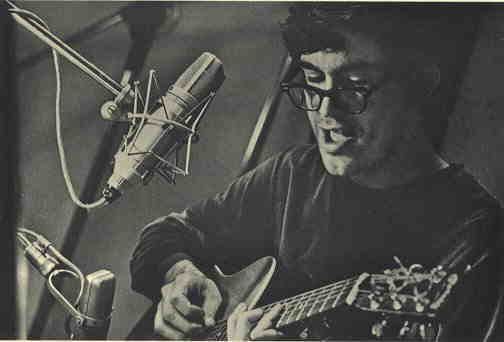Steve Mann
Steve Mann is name-checked on the cover of "Freak Out!" (1966) under the heading "These People Have Contributed Materially In Many Ways To Make Our Music What It Is. Please Do Not Hold It Against Them".
In "The Incredible History Of The Mothers", by FZ (Hit Parader No. 48, June 1969, pages 27, 38-29), there's a (not too friendly) passage referring to Mann: "Also, somewhere along the line, we hired Steve Mann, who is also one of the top blues guitarists on the West Coast. He wanted to play in the group but he couldn't make the changes and we got rid of him."
Although struggling with serious mental problems, he was one of the finest acoustic fingerpickers on the L.A. club scene in the mid-60s playing old blues and ballads. The false rumor of Mann's death by OD in the 60's began with a mistake in the liner notes on a Stefan Grossman album; Grossman still celebrates his memory.
Guitarist Derek Dickson's site (http://drderek.com/personal.htm) mentiones Mann as one of his influences: "I met Steve Mann during this period [the sixties]; he was by far the best folk and blues player that I had heard at that time, he influenced many other guitarists of that period that went on to start a lot of famous bands. He was hanging around the Jefferson Airplane and The Grateful Dead and influenced both of those bands. Steve was also credited with improving Frank Zappa's humor. Dick Rosmini was Steve Mann's guitar teacher and he was very involved in the scene in the late 50's and 60's and was very influential behind the scenes."
Dr. John (Malcolm 'Mac' Rebennack) in his 1994 biography "Under a Hoodoo Moon" reminisces about Steve Mann as follows: "Another kicks character in the celestial realm during these days was Steve 'Lemon' Mann, the guitarist I'd first met in the Sonny & Cher days. He knew all kind of ancient folk licks, which he recycled in his session work and in his own music. He introduced me to Van Dyke Parks, Taj Mahal, Ruth Ann Friedman, and a lot of other people I really dig. Lemon was so spaced in some sessions that the whole guitar section would be facing one way and Lemon the other. You could just not believe the guy was actually going to pull it off and play. He was one of the first people I met who did LSD, heroin, and speed at the same time, but no matter what he was on Lemon could play the guitar to death. I'd used him on a number of sides with Mercury; he had been over the edge then, and got himself stuck in psych wards for long chunks of time. They'd only let him out to do sessions..."
Mann played the 12-string guitar on Sonny & Cher's "I Got You Babe" (1965). Mann did the arrangement for Cher's "All I Really Want To Do" (1965); Sonny Bono (the producer) didn't want Mann's name to appear on the album after he knew he had a hit (Bono took arranger credit on that tune on all but the first pressing of the album, where Mann gets credit).
Jefferson Starship's [i.e. Hot Tuna's] cut "Mann's Fate" is a tribute/rip off of Mann's guitar style. Jorma Kaukonen and Jack Casady visited Mann in Camarillo State Mental hospital and taped riffs they later copied in the studio (released on their first album "Hot Tuna" from 1970).
Musician's News, December 1976, Page 22, Stephen M. H. Braitman, "Steve Mann Live At The Ash Grove": "Steve Mann is a living legend among blues enthusiasts in Southern California. He quit playing around 1967 but those who heard him never forgot. ... Steve Mann's nearly transcendental qualities are quite evident in this superb set... You have only to listen to the work once to know that human tragedy, a portrait of experience, is much of Mann's theme. Equally tragic is the small circle, who still appreciate this musician's work. It should grow."
Guitar Player, March 1977, Volume 11, Number 3, "Steve Mann 'Live' At The Ash Grove": "Of all the white blues artists to come out of the blues revival in the mid-Sixties Steve Mann would have to rank very near the top. Rather than take the 'academic' approach, prevalent with so many of the college/student 'blues interpreters', Mann seems to have genuinely absorbed the feeling of the idiom, more than merely the correct strums and bends. Stefan Grossman called him 'one of the rnost exciting and dynamic guitar players I have ever met', and the cuts contained herein serve only to substantiate that claim..."
